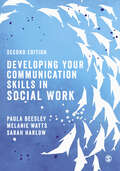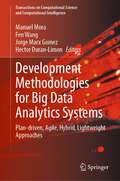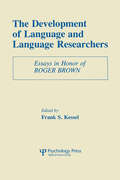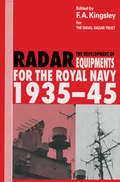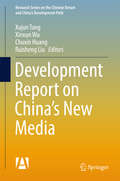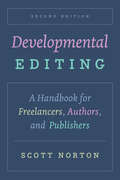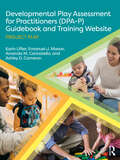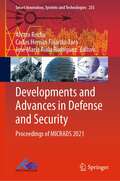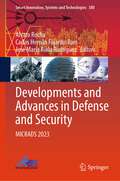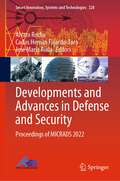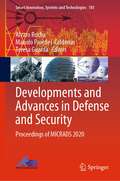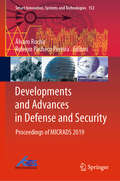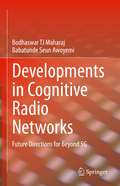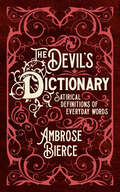- Table View
- List View
Developing Your Communication Skills in Social Work
by Paula Beesley Melanie Watts Sarah HarlowThis book explores: · What is meant by communication skills · What communication skills are · What they look like in practice · The differences in communicating with service users and professionals, such as children, guardians, peers and emergency workers · Why they are important It includes a wide range of theories, multiple case studies, reflective tasks, and exercises. It will develop your critical thinking and reflection skills, and help you develop your own communication style. Presented in a chronological style which acts as a working tool that you can dip into and out of. Each chapter is structured in a way that encourages you to build on your knowledge, so it begins by taking you right back to basics to learn core theory and practice techniques before getting you to critically reflect on the use of different skills in different settings and with different service user groups. The end-of-chapter skills audits help you to reflect on what you have learnt, what your strengths are and what you need to work on more.
Developing Your Communication Skills in Social Work
by Paula Beesley Melanie Watts Sarah HarlowThis book explores: · What is meant by communication skills · What communication skills are · What they look like in practice · The differences in communicating with service users and professionals, such as children, guardians, peers and emergency workers · Why they are important It includes a wide range of theories, multiple case studies, reflective tasks, and exercises. It will develop your critical thinking and reflection skills, and help you develop your own communication style. Presented in a chronological style which acts as a working tool that you can dip into and out of. Each chapter is structured in a way that encourages you to build on your knowledge, so it begins by taking you right back to basics to learn core theory and practice techniques before getting you to critically reflect on the use of different skills in different settings and with different service user groups. The end-of-chapter skills audits help you to reflect on what you have learnt, what your strengths are and what you need to work on more.
Developing Your Communication Skills in Social Work
by Paula Beesley Melanie Watts Sarah HarlowThis book explores: · What is meant by communication skills · What communication skills are · What they look like in practice · The differences in communicating with service users and professionals, such as children, guardians, peers and emergency workers · Why they are important It includes a wide range of theories, multiple case studies, reflective tasks, and exercises. It will develop your critical thinking and reflection skills, and help you develop your own communication style. Presented in a chronological style which acts as a working tool that you can dip into and out of. Each chapter is structured in a way that encourages you to build on your knowledge, so it begins by taking you right back to basics to learn core theory and practice techniques before getting you to critically reflect on the use of different skills in different settings and with different service user groups. The end-of-chapter skills audits help you to reflect on what you have learnt, what your strengths are and what you need to work on more.
Development Methodologies for Big Data Analytics Systems: Plan-driven, Agile, Hybrid, Lightweight Approaches (Transactions on Computational Science and Computational Intelligence)
by Manuel Mora Fen Wang Jorge Marx Gomez Hector Duran-LimonThis book presents research in big data analytics (BDA) for business of all sizes. The authors analyze problems presented in the application of BDA in some businesses through the study of development methodologies based on the three approaches – 1) plan-driven, 2) agile and 3) hybrid lightweight. The authors first describe BDA systems and how they emerged with the convergence of Statistics, Computer Science, and Business Intelligent Analytics with the practical aim to provide concepts, models, methods and tools required for exploiting the wide variety, volume, and velocity of available business internal and external data - i.e. Big Data – and provide decision-making value to decision-makers. The book presents high-quality conceptual and empirical research-oriented chapters on plan-driven, agile, and hybrid lightweight development methodologies and relevant supporting topics for BDA systems suitable to be used for large-, medium-, and small-sized business organizations.
Development of Integrated Reporting in the SME Sector: Case Studies from European Countries (CSR, Sustainability, Ethics & Governance)
by Joanna Dyczkowska Andrea Szirmai Madarasine Adriana Tiron-TudorThis book examines on an international basis how small and medium-sized enterprises (SMEs) cope with the changing economic and social challenges, which are also reflected in financial and non-financial reporting. To this end, it presents six case studies from Germany, Hungary, Romania, Poland, Italy, and the United Kingdom, with a particular focus on integrated reporting (IR). The cases presented are drawn from collaborative research within the international network of INTEREST, an international project on integrated reporting for SME transparency. The book will be of interest to researchers and practitioners.
The Development of Language and Language Researchers: Essays in Honor of Roger Brown
by Frank S. KesselFirst published in 1988. Routledge is an imprint of Taylor & Francis, an informa company.
The Development of Language and Language Researchers: Essays in Honor of Roger Brown
by Frank S. KesselFirst published in 1988. Routledge is an imprint of Taylor & Francis, an informa company.
The Development of Radar Equipments for the Royal Navy, 1935–45
by F. A. KingsleyThis book presents authoritative accounts of the evolution, development and application of Royal Naval radar from its inception in 1935 until the end of World War 2. The accounts are based on the individual authors' contemporary experiences, extensive archival research and discussions with surviving wartime colleagues. An overview is presented of the pioneering work at HM Signal School (later the Admiralty Signal Establishment), followed by descriptions of the main programmes of radar development, associated research, and the problems of installation of the equipment in ships, as well as its operation and maintenance at sea. Tabulations of the characteristics and installations of all wartime Royal Naval radars are provided in the Appendices.
Development Report on China’s New Media (Research Series on the Chinese Dream and China’s Development Path)
by Xujun Tang Xinxun Wu Chuxin Huang Ruisheng LiuIn this book, specialists and scholars present a comprehensive account of the latest developments in Chinese new media. The articles explore important areas such as security of cyberspace in China; the development of WeChat and micro-blogs; public opinions of social media and the transformation of traditional media. It also summarizes the development of the new-media industry, including digital TV, mobile games, the online video industry, IPTV, new-media advertising and mobile news applications. It is a valuable reference work for researchers and professionals working in media.
Developmental Editing, Second Edition: A Handbook for Freelancers, Authors, and Publishers (Chicago Guides to Writing, Editing, and Publishing)
by Scott NortonThe only guide dedicated solely to developmental editing, now revised and updated with new exercises and a chapter on fiction. Developmental editing—transforming a manuscript into a book that edifies, inspires, and sells—is a special skill, and Scott Norton is one of the best at it. With more than three decades of experience in the field, Norton offers his expert advice on how to approach the task of diagnosing and fixing structural problems with book manuscripts in consultation with authors and publishers. He illustrates these principles through a series of detailed case studies featuring before-and-after tables of contents, samples of edited text, and other materials to make an otherwise invisible process tangible. This revised edition for the first time includes exercises that allow readers to edit sample materials and compare their work with that of an experienced professional as well as a new chapter on the unique challenges of editing fiction. In addition, it features expanded coverage of freelance business arrangements, self-published authors, e-books, content marketing, and more. Whether you are an aspiring or experienced developmental editor or an author who works alongside one, you will benefit from Norton’s accessible, collaborative, and realistic approach and guidance. This handbook offers the concrete and essential tools it takes to help books to find their voice and their audience.
Developmental Editing, Second Edition: A Handbook for Freelancers, Authors, and Publishers (Chicago Guides to Writing, Editing, and Publishing)
by Scott NortonThe only guide dedicated solely to developmental editing, now revised and updated with new exercises and a chapter on fiction. Developmental editing—transforming a manuscript into a book that edifies, inspires, and sells—is a special skill, and Scott Norton is one of the best at it. With more than three decades of experience in the field, Norton offers his expert advice on how to approach the task of diagnosing and fixing structural problems with book manuscripts in consultation with authors and publishers. He illustrates these principles through a series of detailed case studies featuring before-and-after tables of contents, samples of edited text, and other materials to make an otherwise invisible process tangible. This revised edition for the first time includes exercises that allow readers to edit sample materials and compare their work with that of an experienced professional as well as a new chapter on the unique challenges of editing fiction. In addition, it features expanded coverage of freelance business arrangements, self-published authors, e-books, content marketing, and more. Whether you are an aspiring or experienced developmental editor or an author who works alongside one, you will benefit from Norton’s accessible, collaborative, and realistic approach and guidance. This handbook offers the concrete and essential tools it takes to help books to find their voice and their audience.
A Developmental-functionalist Approach To Child Language
by Nancy BudwigAlthough there has been much empirical study within what has been referred to as "functional approaches to child language," there has yet to be a major attempt to compare and contrast such proposals. In addition, much of the work carried out within child language from a functionalist perspective has not been specific with regard to the nature of the approach adopted. In attempting to fill the gap, the author of this book begins with a comparison of various functionalist approaches. By concentrating on one domain -- agentivity and control -- Budwig develops a set of research questions based on an examination of findings stemming from linguistics, psycholinguistics, and developmental psychology, and also provides an in-depth discussion of related methodological issues. In the second part of the book, she traces the development of linguistic means to refer to oneself within a developmental-functionalist perspective. Individual case studies as well as group analyses of six children in the early phases of acquiring English grammar are provided. In the last part, Budwig examines the relationship between forms and functions in development with special attention to potential generalizations about the organization and reorganization of the children's linguistic systems.
A Developmental-functionalist Approach To Child Language
by Nancy BudwigAlthough there has been much empirical study within what has been referred to as "functional approaches to child language," there has yet to be a major attempt to compare and contrast such proposals. In addition, much of the work carried out within child language from a functionalist perspective has not been specific with regard to the nature of the approach adopted. In attempting to fill the gap, the author of this book begins with a comparison of various functionalist approaches. By concentrating on one domain -- agentivity and control -- Budwig develops a set of research questions based on an examination of findings stemming from linguistics, psycholinguistics, and developmental psychology, and also provides an in-depth discussion of related methodological issues. In the second part of the book, she traces the development of linguistic means to refer to oneself within a developmental-functionalist perspective. Individual case studies as well as group analyses of six children in the early phases of acquiring English grammar are provided. In the last part, Budwig examines the relationship between forms and functions in development with special attention to potential generalizations about the organization and reorganization of the children's linguistic systems.
Developmental Play Assessment for Practitioners (DPA-P) Guidebook and Training Website: Project Play
by Karin Lifter Emanuel J. Mason Amanda M. Cannarella Ashley D. CameronDevelopmental Play Assessment for Practitioners (DPA-P) Guidebook and Training Website: Project Play offers a comprehensive assessment of naturally occurring play activities for evaluating young children’s developmental progress accurately, so that useful interventions can take place as early as possible. It can be used by practitioners in a wide range of educational and therapeutic settings and is designed to support developmental progress through planning interventions in play, and using what we know about a child’s progress in play to plan play-based interventions in cognition, language, motor, social-emotional, and self-help skills. The guidebook and training website provide a comprehensive introduction to how to successfully use the assessment with infants, toddlers, and young children with disabilities or at risk for disabilities. The comprehensive guidebook offers an overview of the DPA-P and Project Play, defines play, discusses the background literature on play, and explains why this assessment is needed. Clear guidance helps practitioners and family members understand play, how to evaluate play, and how to use play for different purposes. The guidebook offers: an introduction to the comprehensive training website and how to use it understanding of the categories of play assessed and their definitions guidance on how to administer the assessment and prepare a summary evaluation of a child’s performance clear instructions for the coding sheets and scoring guidelines for constructing sets of toys guidance on taking the results of the DPA-P evaluation of a child’s progress in play to develop a plan of activities for intervention explanation of how you evaluate activities at the absence, basic, emergence, and mastery levels for developing a plan suggestions for assembling sets of toys for intervention, based on toys available in children’s homes and early childhood settings procedures for facilitating or teaching play activities to children who are developing more slowly than their peers technical aspects of the assessment To make the DPA-P as flexible as possible for all practitioners, it also offers guidance on adaptations for administering the test, in the coding sheets, with toys to enhance cultural appropriateness for gathering the observations, and for supporting interventions in play. The Developmental Play Assessment for Practitioners (DPA-P) can be used in natural settings and takes 30 minutes to complete. It is a valuable tool for all those who serve, or are training to serve, young children in early childhood settings, schools, service agencies, colleges, and universities. It will be of great benefit for early intervention personnel, speech-language pathologists, physical therapists, occupational therapists, and psychologists.
Developmental Play Assessment for Practitioners (DPA-P) Guidebook and Training Website: Project Play
by Karin Lifter Emanuel J. Mason Amanda M. Cannarella Ashley D. CameronDevelopmental Play Assessment for Practitioners (DPA-P) Guidebook and Training Website: Project Play offers a comprehensive assessment of naturally occurring play activities for evaluating young children’s developmental progress accurately, so that useful interventions can take place as early as possible. It can be used by practitioners in a wide range of educational and therapeutic settings and is designed to support developmental progress through planning interventions in play, and using what we know about a child’s progress in play to plan play-based interventions in cognition, language, motor, social-emotional, and self-help skills. The guidebook and training website provide a comprehensive introduction to how to successfully use the assessment with infants, toddlers, and young children with disabilities or at risk for disabilities. The comprehensive guidebook offers an overview of the DPA-P and Project Play, defines play, discusses the background literature on play, and explains why this assessment is needed. Clear guidance helps practitioners and family members understand play, how to evaluate play, and how to use play for different purposes. The guidebook offers: an introduction to the comprehensive training website and how to use it understanding of the categories of play assessed and their definitions guidance on how to administer the assessment and prepare a summary evaluation of a child’s performance clear instructions for the coding sheets and scoring guidelines for constructing sets of toys guidance on taking the results of the DPA-P evaluation of a child’s progress in play to develop a plan of activities for intervention explanation of how you evaluate activities at the absence, basic, emergence, and mastery levels for developing a plan suggestions for assembling sets of toys for intervention, based on toys available in children’s homes and early childhood settings procedures for facilitating or teaching play activities to children who are developing more slowly than their peers technical aspects of the assessment To make the DPA-P as flexible as possible for all practitioners, it also offers guidance on adaptations for administering the test, in the coding sheets, with toys to enhance cultural appropriateness for gathering the observations, and for supporting interventions in play. The Developmental Play Assessment for Practitioners (DPA-P) can be used in natural settings and takes 30 minutes to complete. It is a valuable tool for all those who serve, or are training to serve, young children in early childhood settings, schools, service agencies, colleges, and universities. It will be of great benefit for early intervention personnel, speech-language pathologists, physical therapists, occupational therapists, and psychologists.
Developments and Advances in Defense and Security: Proceedings of MICRADS 2021 (Smart Innovation, Systems and Technologies #255)
by Álvaro Rocha Carlos Hernan Fajardo-Toro José María Riola RodríguezThis book gathers the proceedings of the Multidisciplinary International Conference of Research Applied to Defense and Security (MICRADS 2021), held at Naval Cadet School "Almirante Padilla", in Cartagena, Colombia, during August 18–20, 2021. It covers a broad range of topics in systems, communication, and defense; strategy and political–administrative vision in defense; and engineering and technologies applied to defense. Given its scope, it offers a valuable resource for practitioners, researchers, and students alike.
Developments and Advances in Defense and Security: MICRADS 2023 (Smart Innovation, Systems and Technologies #380)
by Álvaro Rocha Carlos Hernán Fajardo-Toro José María Riola RodríguezThis book gathers the proceedings of the Multidisciplinary International Conference of Research Applied to Defense and Security (MICRADS 2023), held at Graduate School of the Colombian Air Force, in Bogota, Colombia, during July 6–8, 2023. It covers a broad range of topics in systems, communication, and defense; strategy and political–administrative vision in defense; and engineering and technologies applied to defense. Given its scope, it offers a valuable resource for practitioners, researchers, and students alike.
Developments and Advances in Defense and Security: Proceedings of MICRADS 2022 (Smart Innovation, Systems and Technologies #328)
by Álvaro Rocha Carlos Hernan Fajardo-Toro José María RiolaThis book gathers the proceedings of the Multidisciplinary International Conference of Research Applied to Defense and Security (MICRADS 2022), held at Escuela Naval de Suboficiales ARC "Barranquilla," in Barranquilla, Colombia, during July 11–13, 2022. It covers a broad range of topics in systems, communication, and defense; strategy and political–administrative vision in defense; and engineering and technologies applied to defense. Given its scope, it offers a valuable resource for practitioners, researchers, and students alike.
Developments and Advances in Defense and Security: Proceedings of MICRADS 2020 (Smart Innovation, Systems and Technologies #181)
by Álvaro Rocha Teresa Guarda Manolo Paredes-CalderónThis book gathers the proceedings of the Multidisciplinary International Conference of Research Applied to Defense and Security (MICRADS), held at the Eloy Alfaro Military Academy (ESMIL) in Quito, Ecuador, on May 13–15,2020. It covers a broad range of topics in systems, communication, and defense; strategy and political–administrative vision in defense; and engineering and technologies applied to defense. Given its scope, it offers a valuable resource for practitioners, researchers, and students alike.
Developments and Advances in Defense and Security: Proceedings of MICRADS 2019 (Smart Innovation, Systems and Technologies #152)
by Álvaro Rocha Robson Pacheco PereiraThis book gathers the proceedings of the Multidisciplinary International Conference of Research Applied to Defense and Security (MICRADS), held at the Military Engineering Institute, Rio de Janeiro, Brazil, from 8 to 10th May 2019. It covers a variety of topics in systems, communication and defense; strategy and political-administrative vision in defense; and engineering and technologies applied to defense. Given its scope, it offers a valuable resource for practitioners, researchers, and students alike.
Developments in Cognitive Radio Networks: Future Directions for Beyond 5G
by Bodhaswar TJ Maharaj Babatunde Seun AwoyemiThis book provides holistic yet concise information on what modern cognitive radio networks are, how they work, and the possible future directions for them. The authors first present the most generic models of modern cognitive radio networks, taking into consideration their different architectural designs and classifications. While the spectrum resource is shown to be the most important resource for the cognitive radio networks, the book exposes the importance of the other resources that are needed to help drive the technology. The book then discusses in-depth the key tools (such as optimization and queuing theory) and techniques (such as cooperative diversity and relaying) that are being employed to formulate resource problems, investigate solutions, and interpret such solutions for useful and practical modern cognitive radio networks realization. Further, the book studies the impact of modern cognitive radio networks on other emerging technologies -- such as 5G, Internet of Things, and advanced wireless sensor networks -- and discusses the role that cognitive radio networks play in the evolution of smart cities and in the realization of a highly interconnected world. In discussing the future of the cognitive radio networks, the book emphasizes the need to advance new or improved tools, techniques, and solutions to address lingering problems in the aspects of resource realization and utilization, network complexity, network security, etc., which can potentially limit the cognitive radio networks in their stride to becoming one of the most promising technologies for the immediate and near future.
Device-Edge-Cloud Continuum: Paradigms, Architectures and Applications (Internet of Things)
by Claudio Savaglio Giancarlo Fortino MengChu Zhou Jianhua MaThis book focuses on both theoretical and practical aspects of the “Device-Edge-Cloud continuum”, a development approach aimed at the seamless provision of next-generation cyber-physical services through the dynamic orchestration of heterogeneous computing resources, located at different distances to the user and featured by different peculiarities (high responsiveness, high computing power, etc.). The book specifically explores recent advances in paradigms, architectures, models, and applications for the “Device-Edge-Cloud continuum”, which raises many 'in-the-small' and 'in-the-large' issues involving device programming, system architectures and methods for the development of IoT ecosystem. In this direction, the contributions presented in the book propose original solutions and aim at relevant domains spanning from healthcare to industry, agriculture and transportation.
Device-Free Object Tracking Using Passive Tags (SpringerBriefs in Electrical and Computer Engineering)
by Jinsong Han Wei Xi Kun Zhao Zhiping JiangThis SpringerBrief examines the use of cheap commercial passive RFID tags to achieve accurate device-free object-tracking. It presents a sensitive detector, named Twins, which uses a pair of adjacent passive tags to detect uncooperative targets (such as intruders). Twins leverages a newly observed phenomenon called critical state that is caused by interference among passive tags. The author expands on the previous object tracking methods, which are mostly device-based, and reveals a new interference model and their extensive experiments for validation. A prototype implementation of the Twins-based intrusion detection scheme with commercial off-the-shelf reader and tags is also covered in this SpringerBrief. Device-Free Object Tracking Using Passive Tags is designed for researchers and professionals interested in smart sensing, localization, RFID and Internet of Things applications. The content is also useful for advanced-level students studying electrical engineering and computer science.
Device-to-Device Communications in Cellular Networks (SpringerBriefs in Electrical and Computer Engineering)
by Li Wang Huan TangThis SpringerBrief focuses on crucial issues for device-to-device (D2D) communications within the rapidly expanding 4G LTE toward 5G system. Several critical technical challenges in D2D communications are discussed, and D2D standardization activities in 3GPP are provided. Topics range from proximity discovery and mode selection, to resource management. The authors investigate proximity detection solutions for enabling direct user equipment communication by listening to uplink transmission. The problem of mixed mode selection is demonstrated to meet multiple quality of service (QoS) requirements in D2D enabled cellular networks. Finally, the brief explores the problem of designing interference-constrained resource allocation to pair cellular user resources with potential D2D links in cellular D2D underlay, with the goal of improving spectrum efficiency. Device-to-Device Communications in Cellular Networks targets researchers and professionals working in wireless communications and networks. Advanced-level students in electrical engineering and computer science studying wireless communications and networks can also use this material as a study guide.
The Devil's Dictionary: Satirical Definitions of Everyday Words (G - Reference,information And Interdisciplinary Subjects Ser.)
by Ambrose Bierce"Politeness, n. The most acceptable hypocrisy."In this extraordinary work of scathing satire, Ambrose Bierce provided new humorous definitions of the words that formed the lexicon of contemporary American life.Accumulated over three decades for a series of magazines and newspapers, the entries in The Devil's Dictionary painted a revealing portrait of late 19th-century American life, with all its contradictions and hypocrisies laid bare.Bierce's fantastic wit and incredible gift for irony shine through this true masterpiece of American literature.
